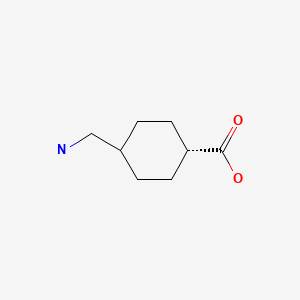Attribution Statement: LactMed is a registered trademark of the U.S. Department of Health and Human Services.
NCBI Bookshelf. A service of the National Library of Medicine, National Institutes of Health.
Drugs and Lactation Database (LactMed®) [Internet]. Bethesda (MD): National Institute of Child Health and Human Development; 2006-.
CASRN: 1197-18-8

Drug Levels and Effects
Summary of Use during Lactation
Amounts of tranexamic acid in breastmilk appear to be low. Although an international consensus panel recommended against using tranexamic acid during breastfeeding,[1] a subsequent controlled study found no adverse outcomes among breastfed infants whose mothers took tranexamic acid in dosages up to 4 grams daily during breastfeeding. One center in Canada reports routine use of tranexamic acid 3 grams daily in nursing mothers with bleeding disorders until bleeding stops.[2] Tranexamic acid is used for hereditary angioedema in low-income countries where first-line treatments are not available, but should not be used if C1-INH is available.[3] If tranexamic acid is required by a mother, it is not a reason to discontinue breastfeeding; however, until more data become available, medical supervision and follow-up of the breastfed infant is recommended.[4]
Drug Levels
Maternal Levels. Unpublished data from the manufacturer indicates that the concentration of tranexamic acid in breastmilk is 1% of the peak serum concentration 1 hour after the last dose of a 2-day treatment course.[5] Further details of the study have not been published.
A dose-finding study of 30 women who received either 5, 10 or 15 mg/kg of tranexamic acid at the time of cord clamping after cesarean delivery collected convenience samples of milk at unspecified times when mothers were nursing their neonates. Tranexamic acid levels in milk were measured in 7 patients. Three samples had no detectable tranexamic acid (<0.04 mg/L). The other samples contained tranexamic acid concentrations ranging from 0.06 to 0.47 mg/L.[6]
Infant Levels. Relevant published information was not found as of the revision date.
Effects in Breastfed Infants
Twenty-one mothers who took tranexamic acid during breastfeeding were compared to 42 mothers who took amoxicillin during breastfeeding. In the study population, the tranexamic acid dosage ranged between 1.5 and 4 grams daily at an average of 4.2 months of age and 81% exclusively breastfed their infants. The average time of follow-up of the infants of study mothers was 35.7 months of age. No statistically significant difference were found between the study and control groups in possible drug side effects, neurological development or general health.[4]
A randomized, double-blind, multicenter study compared the use of a 1 gram dose of intravenous tranexamic acid (n = 10,051) to placebo (n = 10,009) in women with postpartum hemorrhage. The dose could be repeated in 24 hours if bleeding recurred. Among babies who were breastfed, no difference in infant deaths were seen between the two groups, nor were any thromboembolic events reported. The numbers of breastfed infants in each group were not reported.[7]
Effects on Lactation and Breastmilk
Relevant published information was not found as of the revision date.
References
- 1.
- Caballero T, Farkas H, Bouillet L, et al. International consensus and practical guidelines on the gynecologic and obstetric management of female patients with hereditary angioedema caused by C1 inhibitor deficiency. J Allergy Clin Immunol. 2012;129:308–20. [PubMed: 22197274]
- 2.
- Hawke L, Grabell J, Sim W, et al. Obstetric bleeding among women with inherited bleeding disorders: A retrospective study. Haemophilia. 2016;22:906–11. [PubMed: 27704714]
- 3.
- Yeich A, Elhatw A, Ashoor Z, et al. Safety of medications for hereditary angioedema during pregnancy and lactation. Expert Opin Drug Saf. 2023;22:17–24. [PubMed: 36744397]
- 4.
- Gilad O, Merlob P, Stahl B, et al. Outcome following tranexamic acid exposure during breastfeeding. Breastfeed Med. 2014;9:407–10. [PubMed: 25025926]
- 5.
- Verstraete M. Clinical application of inhibitors of fibrinolysis. Drugs. 1985;29:236–61. [PubMed: 2580684]
- 6.
- Ahmadzia HK, Luban NLC, Li S, et al. Optimal use of intravenous tranexamic acid for hemorrhage prevention in pregnant women. Am J Obstet Gynecol. 2021;225:85.e1–85.e11. [PMC free article: PMC8149481] [PubMed: 33248975]
- 7.
- Shakur H, Roberts I, Fawole B, et al. Effect of early tranexamic acid administration on mortality, hysterectomy, and other morbidities in women with post-partum haemorrhage (WOMAN): An international, randomised, double-blind, placebo-controlled trial. Lancet. 2017;389:2105–16. [PMC free article: PMC5446563] [PubMed: 28456509]
Substance Identification
Substance Name
Tranexamic Acid
CAS Registry Number
1197-18-8
Disclaimer: Information presented in this database is not meant as a substitute for professional judgment. You should consult your healthcare provider for breastfeeding advice related to your particular situation. The U.S. government does not warrant or assume any liability or responsibility for the accuracy or completeness of the information on this Site.
- User and Medical Advice Disclaimer
- Drugs and Lactation Database (LactMed) - Record Format
- LactMed - Database Creation and Peer Review Process
- Fact Sheet. Drugs and Lactation Database (LactMed)
- Drugs and Lactation Database (LactMed) - Glossary
- LactMed Selected References
- Drugs and Lactation Database (LactMed) - About Dietary Supplements
- Breastfeeding Links
- PMCPubMed Central citations
- PubChem SubstanceRelated PubChem Substances
- PubMedLinks to PubMed
- Review Nalidixic Acid.[Drugs and Lactation Database (...]Review Nalidixic Acid.. Drugs and Lactation Database (LactMed®). 2006
- Review Valproic Acid.[Drugs and Lactation Database (...]Review Valproic Acid.. Drugs and Lactation Database (LactMed®). 2006
- Review Etidronate.[Drugs and Lactation Database (...]Review Etidronate.. Drugs and Lactation Database (LactMed®). 2006
- Review Ioxaglate.[Drugs and Lactation Database (...]Review Ioxaglate.. Drugs and Lactation Database (LactMed®). 2006
- Review Ursodiol.[Drugs and Lactation Database (...]Review Ursodiol.. Drugs and Lactation Database (LactMed®). 2006
- Tranexamic Acid - Drugs and Lactation Database (LactMed®)Tranexamic Acid - Drugs and Lactation Database (LactMed®)
Your browsing activity is empty.
Activity recording is turned off.
See more...
